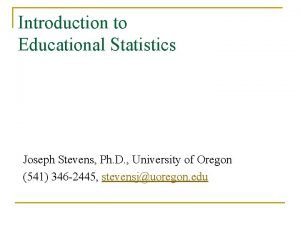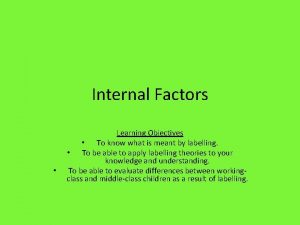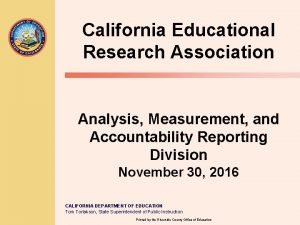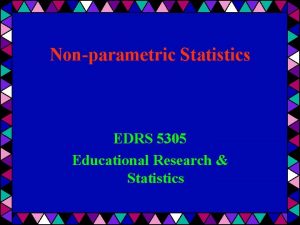Educational statistics 1 1 What is Statistics Statistics








![Substituting the values in the formula: • Median = L + [N/2 –Cumfb] x Substituting the values in the formula: • Median = L + [N/2 –Cumfb] x](https://slidetodoc.com/presentation_image/4a2adbf1bd3e61b751577675bb46cfbc/image-9.jpg)
![• Median = 19. 5 + [ 50/2 – 21 ] x 5 • Median = 19. 5 + [ 50/2 – 21 ] x 5](https://slidetodoc.com/presentation_image/4a2adbf1bd3e61b751577675bb46cfbc/image-10.jpg)










- Slides: 20

Educational statistics

1. 1: What is Statistics? Statistics: The science of collecting, describing, and interpreting data. Two areas of statistics: Descriptive Statistics: collection, presentation, and description of sample data. Inferential Statistics: making decisions and drawing conclusions about populations.

Example: A college principal is interested in learning about the average of faculty. Identify the basic terms in this situation. The population is the age of all faculty members at the college. A sample is any subset of that population. For example, we might select 10 faculty members and determine their age. The variable is the “age” of each faculty member. One data would be the age of a specific faculty member. The data would be the set of values in the sample. The experiment would be the method used to select the ages forming the sample and determining the actual age of each faculty member in the sample. The parameter of interest is the “average” age of all faculty at the college. The statistic is the “average” age for all faculty in the sample.

Calculation of Mean (long method) Class Interval (CI) Mid-Point (X) Frequency (f) 45 -49 2 40 -44 3 35 -39 2 30 -34 6 25 -29 8 20 -24 8 15 -19 7 10 -14 5 5 -9 9 N=50 Frequency x Midpoint (f x X)

Calculation of Mean (long method) Class Interval (CI) Mid-Point (X) Frequency (f) Frequency x Midpoint (f x X) 45 -49 47 2 94 40 -44 42 3 126 35 -39 37 2 74 30 -34 32 6 192 25 -29 27 8 216 20 -24 22 8 176 15 -19 17 7 119 10 -14 12 5 60 5 -9 7 9 63 N=50 Σf. X=1120

Substituting the values in the formula: • Or Mean = Σf. X N Mean = 1120 50 = 22. 40

Calculation of Median Class Interval (CI) Exact-Limits Frequency (f) 45 -49 2 40 -44 3 35 -39 2 30 -34 6 25 -29 8 20 -24 8 15 -19 7 10 -14 5 5 -9 9 N=50 Cumulative Frequency (Cumf) Medianlies. CI= N/2

Calculation of Median Class Interval (CI) Exact-Limits Frequency (f) Cumulative Frequency (Cumf) 45 -49 44. 5 -49. 5 2 50 40 -44 39. 5 -44. 5 3 48 35 -39 34. 5 -39. 5 2 45 30 -34 29. 5 -34. 5 6 43 25 -29 24. 5 -29. 5 8 37 20 -24 19. 5 -24. 5 8 29 15 -19 14. 5 -19. 5 7 21 10 -14 9. 5 -14. 5 5 14 5 -9 4. 5 -9. 5 9 9 N=50
![Substituting the values in the formula Median L N2 Cumfb x Substituting the values in the formula: • Median = L + [N/2 –Cumfb] x](https://slidetodoc.com/presentation_image/4a2adbf1bd3e61b751577675bb46cfbc/image-9.jpg)
Substituting the values in the formula: • Median = L + [N/2 –Cumfb] x i fw L = exact lower limit of the C I in which the median lies (19. 5) Cumfb= cumulative frequency below the C I containing Median (21) fw = frequency within the C I containing the Median (8) i = size of the C I (5)
![Median 19 5 502 21 x 5 • Median = 19. 5 + [ 50/2 – 21 ] x 5](https://slidetodoc.com/presentation_image/4a2adbf1bd3e61b751577675bb46cfbc/image-10.jpg)
• Median = 19. 5 + [ 50/2 – 21 ] x 5 8 • = 19. 5 + [ 25 – 21 ] x 5 8 • = 19. 5 + 4 x 5 8 • = 19. 5 + 2. 5 • = 22

Mode • The Mode refers to the number that occurs the most frequently. • It’s easy to remember… the first two numbers are the same! MOde and MOst Frequently!

Calculation of mode • • • Mode = 3 Median - 2 Mean from the distribution given above : Median = 22 and Mean = 22. 40 Substituting the values given above Mode = 3 x 22 – 2 x 22. 40 = 21. 2

Calculation of Mode Class Interval (CI) Exact limits Frequency (f) 45 -49 44. 5 -49. 5 2 40 -44 39. 5 -44. 5 3 35 -39 34. 5 -39. 9 2 30 -34 29. 5 -34. 5 6 25 -29 24. 5 -29. 5 8 20 -24 19. 5 -24. 5 8 15 -19 14. 5 -19. 5 7 10 -14 9. 5 -14. 5 5 5 -9 4. 5 -9. 5 9 N=50

• Mode = L + f – fb x i (f-fb) + (f-fa) L= exact lower limit of modal class interval f= frequency of the modal class interval fb= frequency below the modal class interval fa= frequency above the modal class interval i= size of the class interval • L = 25, f = 8, fb= 8, i = 5, fa = 6 • Mode = 24. 5 + 8– 8 x 5 (8 -8) + (8 -6) = 21. 5

Measures of variability • Average deviation • Standard deviation • Quartile deviation

Average deviation • The average deviation is the average distance between the mean and scores in the distributions

Calculate average deviation from grouped data Class interval Mid-Point X Frequency f 50 -59 2 40 -49 4 30 -39 12 20 -29 15 10 -19 10 0 -9 7 N=50 f. X X-M |X-M| f|X-M|

Calculate average deviation from grouped data Class interval Mid-Point X Frequency f f. X X-M |X-M| f|X-M| 50 -59 54. 5 2 109 +29. 6 59. 2 40 -49 44. 5 4 178 +19. 6 19, 6 78. 4 30 -39 34. 5 12 414 +9. 6 115. 2 20 -29 24. 5 15 367. 5 0. 4 6. 0 10 -19 14. 5 10 145 -10. 4 104. 0 0 -9 4. 5 7 31. 5 -20. 4 142. 8 N=50 Σf. X=1245 Σf|X-M|=505. 6

• Mean = Σf. X N Mean = 1245 = 24. 9 50 Average Deviation= Σf|X-M| = 505. 6 =10. 11 N 50

 Introduction to educational statistics
Introduction to educational statistics Introduction to statistics what is statistics
Introduction to statistics what is statistics Conclusion of educational psychology
Conclusion of educational psychology Constructivist approach
Constructivist approach Educational psychology conclusion
Educational psychology conclusion Idealul educational
Idealul educational Images of cultural and educational rights
Images of cultural and educational rights It’s educational – lesson 5
It’s educational – lesson 5 Educational triage
Educational triage Albert bandura theory
Albert bandura theory Content and learning outcome examples
Content and learning outcome examples Proiect educational 1 decembrie clasa 1
Proiect educational 1 decembrie clasa 1 Three branches of philosophy
Three branches of philosophy Proiect educational 1 martie
Proiect educational 1 martie Educational management
Educational management Kyrene educational resources
Kyrene educational resources Objectives
Objectives California educational research association
California educational research association Federal state autonomous educational institution
Federal state autonomous educational institution Educational data systems inc
Educational data systems inc Living educational theory
Living educational theory







































